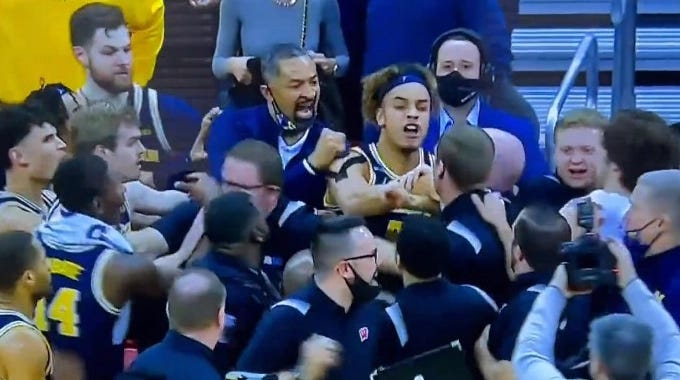What is “Violence,” Exactly?
On Monday, Michigan’s head coach Juwan Howard was suspended five games for throwing a punch at Wisconsin assistant Joe Krabbenhoft after their two teams played on Sunday. Apparently, Howard was not happy with the decision of Wisconsin head coach Greg Gard to call a timeout in the final seconds of a game Wisconsin was already winning by 14. So, Howard said something harsh to Gard during the postgame handshake, Gard grabbed Howard to respond, Howard reacted angrily, their assistants tried to separate them, and Howard eventually took an open-fisted swing at Krabbenhoft.
The whole thing was pretty ugly, but a five-game suspension, plus a $40,000 fine—along with other penalties assessed to Gard and others who took part in the melee—feels about right. Howard apologized, both for the punch and for his apparent lack of contrition in the game’s immediate aftermath, and it seems like everyone is willing to move on. After all, that’s how things are supposed to work: Howard did something wrong, was punished for it, and acknowledged he made a mistake.
But what’s most interesting to me about it is the way it illustrates a problem with discussing “violence.” Violence seems like it is easy to identify; so many crucial distinctions—legal distinctions, but also moral and rhetorical distinctions—depend on being able to easily identify what is violent and what is not. But something like the Howard incident shows it is not really that simple.
At the end of the video, it’s easy—I think anyone would concede that throwing your right hand at someone, even with an open fist, is violent. It’s aggressive, uninvited physical contact. But what about earlier in the video? The confrontation began with Gard grabbing Howard aggressively—not really in a manner I’d call “violent,” but I’m not sure exactly what the difference is. After all, he is also engaging in aggressive, uninvited physical contact. As Howard put it in his postgame press conference, “He was touching me unnecessarily—it wasn’t called for that when we were talking and at that point I thought it was time to protect myself.”
The key difference, I suppose, is that Gard is not trying to hurt Howard. This looks obvious in the video, but scanning intent is difficult in the moment, and it’s easy to imagine scenarios where intent is never clear. And even if you don’t classify Gard’s actions as violent (and some people do), it’s impossible to evaluate Howard’s reaction without seeing what started the whole incident.
Again, none of this is meant to relitigate Howard’s suspension, but merely to use this incident as a way to think about how we use a loaded term like “violence.” Because most violence is like this: It starts as a normal, nonviolent confrontation and then gradually escalates until, at some point, we’ve reached violence. But when exactly that line gets crossed is rarely as clear as we make it out to be. Watch the video of Howard and Gard again and try to identify the precise moment when it becomes “violent.” If you asked multiple people, you’d probably get a wide range of answers, probably clustered around the moment Howard swung his fist.
But a lot of the focus on Howard comes from his size, his race, his position as the head coach, etc. He is in a position of heightened scrutiny, so that moment stands out, even though there were other people around him, jostling and shoving. Most of them were trying to break the confrontation up, but was that obvious to everyone in the moment? Based on Howard’s comments about defending himself, he clearly thought he was already in a fight when he threw the “punch.”
All of this is merely to say that the line between “violence” and “nonviolence” is not as clear as we often make it out to be. And yet that line has such massive implications for so many people. Whether an accused criminal gets bail, how they are charged, whether an incarcerated person is paroled… so many decisions made by our inhumane criminal justice system depend on whether we consider the person “violent.” And it’s not just legal weight that the word carries, but moral weight. Think of how political protests and movements are discredited for being associated with “violence.” Think of how average people are so much less willing to extend mercy to “violent” criminals than supposedly nonviolent ones.
What makes this so tricky is that “violence” is unlike many other politically contested terms. When people use terms like “propaganda” or “racist” or “working class,” they usually know that people will disagree on how exactly to apply those terms. But “violence” feels different. We think we all know what it is. It should be obvious. That’s why it carries such moral force, and it’s so easy to condemn violent protesters or violent prisoners or violent criminals. We think we know what we’re talking about. But the Juwan Howard incident shows that even when it’s caught on tape, it’s not that simple.




